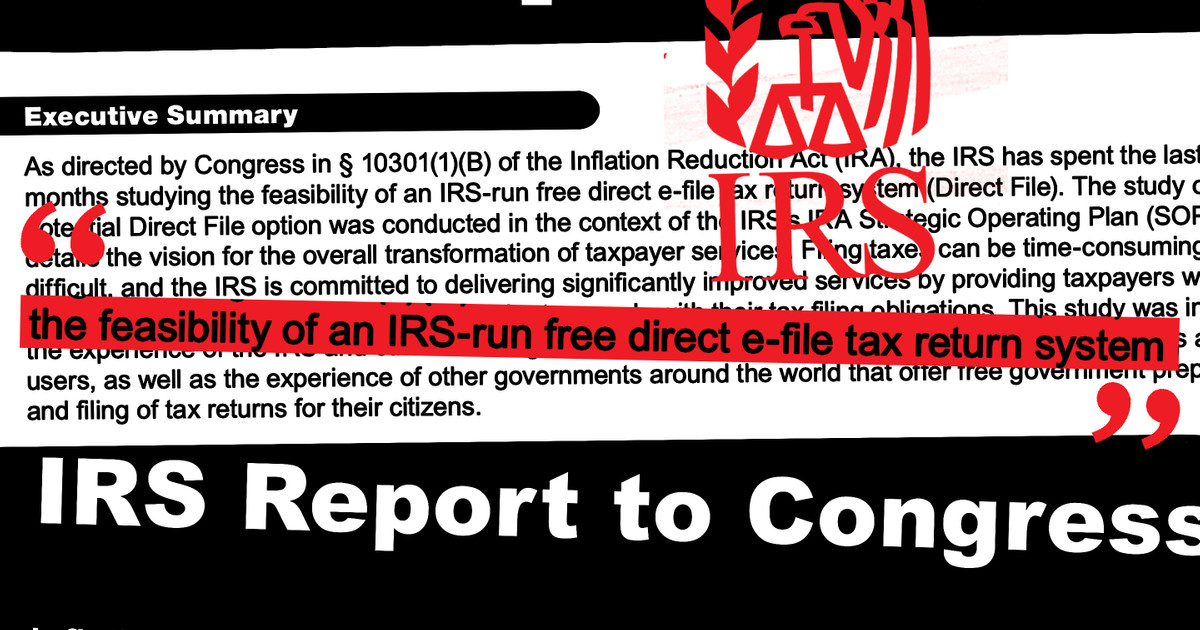The IRS on Tuesday announced that it would develop an experimental online tool to allow Americans to file taxes directly with the agency for free.
It’s a major development — one in which ProPublica’s reporting played a significant role — given that most U.S. taxpayers pay to file and the tax preparation industry has long held sway in Washington. Only four years ago, the industry nearly succeeded in getting a law passed that would have barred the IRS from providing direct filing.
The limited pilot, as the IRS called it, is only a first step intended to gather information, and the IRS made clear that if it does proceed with a direct filing platform beyond this test, it will scale up gradually. Under the most optimistic scenario, it will be at least a few years before the IRS offers a direct option for millions of taxpayers.
The IRS would need funding to operate a broad program, and there will be continued opposition to the agency taking that path. The tax prep industry, particularly TurboTax-maker Intuit and H&R Block, will likely keep spending big on lobbyists to stop the IRS from competing with them. Republicans in Congress have already criticized the idea of free direct filing and want to cut IRS funding.
But the pilot is a possible turning point in a fight that goes back decades — as ProPublica has covered extensively — and seems sure to continue years into the future.
The IRS announcement came as it released a report, required by last year’s Inflation Reduction Act, on the possibility of a direct file program. The IRS found wide public support in surveys for the idea of a direct file portal and laid out a range of possibilities of who might be able to use it. (It seems certain the tool would be geared toward taxpayers with relatively simple returns.) After the report was completed, President Joe Biden’s Treasury Department directed the IRS to conduct a pilot program.
All that’s clear about the pilot is that it will occur next year, will involve a very limited number of taxpayers and will be a question-based tool similar to commercial tax prep. The point of the trial, IRS and Treasury Department officials said on a call with reporters, was to gather more information on what form such a direct filing tool would ultimately take. It would then be up to the Biden administration “whether to move to the next level of full-scale implementation,” IRS Commissioner Danny Werfel said.
One of the main thrusts of the report was that maintaining a direct filing program would cost a significant amount. The main hurdle was not building the software tool but providing customer service support for users. The more people who use the tool, the more customer service agents are needed. As a result, for 25 million users, the report estimated an annual cost north of $200 million, with over 80% going to customer service. That’s around $10 per return filed.
Americans who purchase tax prep software pay multiples of that figure. TurboTax paid products, for example, range in price from $69 to $129 for federal returns, with additional fees for state tax returns.
The need for continued funds would likely create frictions in Congress. In the short-term, the IRS can tap some of the $80 billion it received as part of the Inflation Reduction Act. But only a small portion of that, $3.2 billion, was directed to taxpayer services, and the IRS has already articulated plans for how to use it. To support a program in the long term, the IRS would need enough money appropriated along with its other taxpayer service demands.
Republicans, who forced huge cuts to the IRS budget last decade, remain critical of the agency and skeptical of the need for increased funding. One of the first acts of the new House majority was to pass a bill to repeal the $80 billion the IRS received in the Inflation Reduction Act.
At a congressional hearing last month, Rep. Jason Smith, R-Mo., chief of the House Ways and Means Committee, said that “asking the IRS to do your taxes is like asking your kid to guard the cookie jar.” Rep. Darin LaHood, R-Ill., observed that “the tax preparation industry already provides free filing services for roughly 30 million returns each year. So, I’m not quite sure why trying to tackle this concept in the near term would be beneficial.”
Since the 2000s, TurboTax has drawn customers with the promise of “free” tax prep while deploying a deep bag of tricks to turn many into paying customers, sometimes by convincing them to purchase add-on services, sometimes by charging them because they have a wrinkle like a deduction for student loan interest. Customers who run that gantlet can indeed receive free tax prep.
The IRS’ Free File Program, a collaboration between the agency and the tax prep industry to provide free services to most taxpayers, will continue to limp along. The industry forged the program as a way to keep the IRS from developing its own direct option. But after ProPublica reported in 2019 that the companies were intentionally downplaying IRS Free File in order to push customers to their own “free” options, the program began to unravel. TurboTax and H&R Block backed out, leaving lesser-known companies as the only participants. Last year, 3 million people used Free File.
Meanwhile, in coming years the filing experience figures to improve, whether taxpayers pay for prep or not. Much of tax filing involves entering in data from forms like W-2s and 1099s, a process that should be unnecessary, given that employers, brokerages and the like also transmit the same data to the IRS each year. The agency has not had the technology to share this data with taxpayers when they file. As part of the tech upgrades the agency is planning with the $80 billion boost, the IRS says that by 2025 it will be able to prefill that info. “The information will be provided in a format that can interact directly with return preparation software or can be taken to a return preparer when authorized by the taxpayer,” according to the agency’s plan.
Dozens of other countries have systems that pre-fill information, making it possible for taxpayers, if they have to file a return at all, to simply make sure the info looks accurate. The idea of anything like that in the U.S. has long been far-fetched, given the entrenched opposition from profit-making corporations. The possibility for even a sliver of Americans to use that tool is still years off. But for the first time, the government is taking real steps in that direction.
Do You Have a Tip for ProPublica? Help Us Do Journalism.
Got a story we should hear? Are you down to be a background source on a story about your community, your schools or your workplace? Get in touch.




